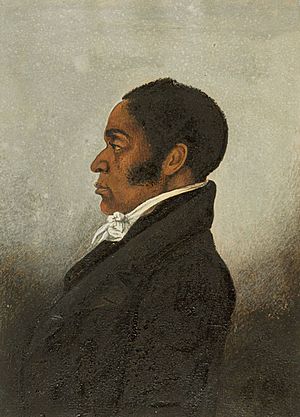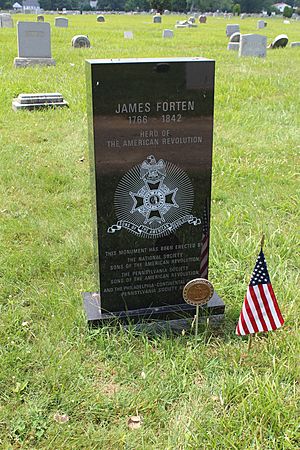James Forten facts for kids
Quick facts for kids
James Forten
|
|
|---|---|

portrait of James Forten, c.1834, probably by Robert Douglass Jr.
|
|
| Born | September 2, 1766 |
| Died | March 4, 1842 (aged 75) Philadelphia, Pennsylvania, U.S.
|
| Occupation | Sailor, sailmaker, merchant, investor, businessman, landlord, essayist, abolitionist |
| Spouse(s) | Martha Beatty Charlotte Vandine |
| Children | Robert Bridges Forten Margaretta Forten Harriet Forten Purvis Sarah Louisa Forten Charlotta Forten William Deas Forten Mary Theresa Forten Thomas Willing Francis Forten James Forten, Jr. |
| Relatives | Robert Purvis (son-in-law) , Charlotte Forten Grimké (granddaughter), Charles Burleigh Purvis (grandson), Harriet Purvis, Jr. (granddaughter), William B. Purvis (grandson) |
James Forten (September 2, 1766 – March 4, 1842) was a very important African-American abolitionist and a successful businessman. He lived in Philadelphia, Pennsylvania. Born free, he became a sailmaker after the American Revolutionary War. He later bought the business where he worked. Forten became very wealthy and used his money and influence to fight for civil rights for African Americans. He worked to end slavery across the United States.
Contents
Early Life and Education
James Forten was born free in Philadelphia on September 2, 1766. His father, Thomas Forten, was a sailmaker. James started working at age seven to help his family after his father died. He was a chimney sweep and then a grocery store clerk. He also went to the African School, which was run by Quakers who believed in ending slavery. This school taught black children for free.
At 14, during the American Revolutionary War, Forten joined a ship called the Royal Louis. This ship was a privateer, which means it was a private ship allowed to attack enemy ships during wartime. The British Navy captured the Royal Louis. Forten became a prisoner of war. He was held on a prison ship called HMS Jersey for seven months.
After his release, Forten promised not to fight in the war again. He walked from Brooklyn back to Philadelphia. He then worked on a merchant ship that sailed to England. He lived and worked in a London shipyard for over a year. When he returned to Philadelphia in 1790, he became an apprentice to Robert Bridges, a sailmaker who had employed his father. Forten quickly learned the trade and became a foreman.
A Successful Business Career
In 1798, Robert Bridges retired, and James Forten bought the sail loft. A sail loft is where large ship sails are cut and sewn. Forten invented a special tool to help move the big sails. By 1810, his business was one of the most successful in Philadelphia. He was fair to his workers, hiring both black and white people. Because he was so good at business, Forten became one of the richest people in Philadelphia.
Family and Their Fight for Freedom
James Forten married twice. His first wife, Martha Beatty, died shortly after they married. In 1806, he married Charlotte Vandine. They had nine children: Robert Bridges, Margaretta, Harriet, Sarah Louisa, Charlotta, William Deas, Mary Theresa, Thomas Willing Francis, and James, Jr. Robert and James Jr. later took over their father's sailmaking business.
All of Forten's children were dedicated to the abolition movement. This was the movement to end slavery. For example, Robert was a strong anti-slavery activist. Harriet and Sarah Louisa married brothers, Robert Purvis and Joseph Purvis, who were also important abolitionists. Margaretta became a teacher and an officer in the Philadelphia Female Anti-Slavery Society. Forten's granddaughter, Charlotte Forten Grimké, became a poet and educator.
Fighting for Civil Rights
Once he was successful, James Forten spent much of his time and money fighting for the end of slavery. He also worked to gain civil rights for black people. At this time, black people in the North often faced discrimination. They usually could not vote or serve on juries. Forten felt it was his duty to help his community. In 1801, he signed a petition to the U.S. Congress. It asked for the end of the slave trade and changes to the Fugitive Slave Law.
In 1813, Forten wrote a pamphlet called Letters From A Man of Colour. A pamphlet is a small booklet. He wrote it to oppose a bill in Pennsylvania. This bill would have required all black people moving to Pennsylvania to register with the state. Forten argued that this bill would violate the rights of free black people. He believed it would treat them differently from white people. The bill did not pass, and Forten became known for his strong writing.
Opposing Colonization
In the early 1800s, some people supported sending free black Americans to live in Africa, Canada, or Haiti. The American Colonization Society (ACS) was formed in 1816. It wanted to create a colony in West Africa called Liberia for this purpose. Some members of the ACS were abolitionists, while others were slaveholders. They believed that sending free black people to Africa would solve the "problem" of black people in American society.
James Forten had supported Paul Cuffee, a shipbuilder who took 38 free black people to Sierra Leone in 1815. Cuffee believed they could have a better life there, away from racism. However, Forten soon changed his mind about colonization.
In January 1817, Forten helped organize a meeting in Philadelphia with Bishop Richard Allen. Three thousand people attended this meeting at Bethel AME Church. Forten asked the crowd if they supported colonization. Not one person said yes. When he asked who was against it, the crowd shouted "No!" loudly. Most black Americans had been born in the United States for generations. They felt it was their home and wanted to gain full civil rights there.
After this meeting, Forten and other leaders strongly opposed the ACS. Forten also convinced William Lloyd Garrison, a young white abolitionist, to oppose colonization. Forten helped Garrison start his newspaper, The Liberator, in 1831. Forten often wrote letters for the newspaper, signing them "A Colored Man of Philadelphia." Garrison also wrote articles against colonization, explaining the difficult conditions in Liberia. They wanted people to know that the ACS was not always acting in the best interest of black Americans.

James Forten continued to manage his sail loft and stay active in the abolitionist movement. He kept writing for The Liberator until late in his life. He died on March 4, 1842, at age 75 in Philadelphia. Thousands of people, both black and white, attended his funeral.
Legacy and Honors
James Forten left behind a strong family, a large fortune, and a history of helping others and fighting for justice. His work inspired many black Philadelphians for generations. In 2001, scholar Molefi Kete Asante included James Forten on his list of 100 Greatest African Americans.
Death
James Forten died on March 4, 1842, in Philadelphia, Pennsylvania. He is buried at Eden Cemetery in Collingdale, Pennsylvania.

